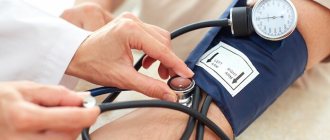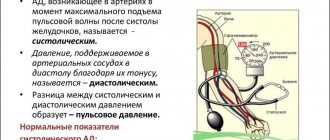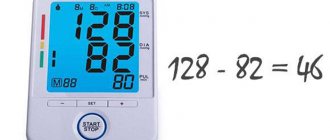Blood pressure specialists assess the functional state of the vascular and cardiac systems. Thus, systolic pressure reflects the activity of blood vessels, and diastolic pressure reflects the activity of the heart. The difference between the two values is called pulse pressure, on average it is 30-40 mm. rt. Art. Significant deviations in values indicate the development of pathological processes in the body, which are considered as hypertension and hypotension. However, some patients may experience isolated hypertension, when a pressure of 120 over 50 does not correspond to accepted standards. What does this condition mean and what causes it?
What does a blood pressure level of 90/50 mean?
In a healthy person, normal blood pressure ranges from 120/80 to 110/70 mm. rt. Art. Therefore, a pressure of 90 to 50 is considered a pathological manifestation for people of different age groups. A simultaneous decrease in cardiac and renal pressure is a manifestation of insufficient circulating blood volume, which leads to a deficiency of oxygen and nutrients in the body. This causes a disorder in the functional activity of vital organs, namely damage to the myocardium and brain.
Indicators of 90 to 50 are considered arterial hypotension. In this condition, the lumen of blood vessels expands, resulting in a decrease in the productive work of the heart muscle and a decrease in blood flow. In most cases, hypotension is a secondary pathology; low blood pressure occurs against the background of other diseases.
Norm or pathology
If a pressure of 90 to 50 does not provoke the development of symptoms and signs of hemodynamic disturbances, then this can be considered as physiological hypotension. This condition is individual, and is more often diagnosed in young people, especially girls. It is difficult to eliminate primary hypotension, since the compensatory mechanisms responsible for the regulation of blood pressure have adapted to maintain it at a minimum level.
Hypotension is considered to be pathological, in which characteristic disturbances and complaints of deterioration of well-being are observed. It is observed in patients with normal or elevated blood pressure. Oxygen deficiency causes damage to the myocardium and brain, which causes the clinical picture of hypotension.
No ads 1
conclusions
With this pressure value - 110/50 (you already know what this means), you need to be wary, since such blood pressure indicators can be both normal and pathological.
It is quite easy to distinguish whether this is normal or not. With this problem (namely: what does pressure 100/55 mean), you just need to listen to yourself and your well-being.
If there are side factors - fever, vomiting, nausea (or pressure appeared due to injury), then you should urgently consult a therapist.
Reasons for the development of low blood pressure
A decrease in blood pressure is usually associated with a violation of the mechanism of its regulation. The following are the causes of hypotension that provoke a decrease in blood pressure:
- Decrease in circulating blood volume (internal bleeding, dehydration, vomiting, diarrhea).
- Insufficient pumping activity of the myocardium (cardiomyopathy, heart attack, arrhythmia, heart failure).
- Disorder of hormone production by the endocrine glands (hypothyroidism, Addison's disease).
- Dysregulation of vascular tone (diseases of the nervous system, stress, neoplasms, traumatic brain injury, stroke).
- Excessive expansion of arterioles (intoxication, poisoning, burns, overdose of antihypertensive drugs).
Women are more susceptible to hypotension, especially during the period of hormonal changes in the body, during which there may be no symptoms.
If the diastolic reading is 50
A decrease in the lower indicator can be caused by both physiological and pathological processes in the body. The physiological form is typical for young people with an asthenic body constitution and hereditary predisposition. The condition does not cause any disturbance of well-being or discomfort.
Vegetative-vascular dystonia can be the primary cause of the disease and subsequently become chronic. Low blood pressure can be caused by the following factors:
- diseases of the urinary system;
- decreased thyroid function;
- allergic reaction;
- damage to the adrenal cortex;
- peptic ulcer of the digestive tract;
- pinching of the cervical vertebrae;
- anemia;
- malignant neoplasms;
- starvation;
- infectious diseases.
A one-time detection of a hypotensive state does not require therapeutic measures; if blood pressure is constantly low, it is necessary to undergo an examination to determine its cause and select the optimal therapy.
What pathologies cause a high pulse difference?
The pressure is 120 over 50, at which the pulse pressure is 70 mm. rt. Art., is high. A prolonged increase signals the development of pathological conditions requiring emergency medical care.
Pathologies that cause a high pulse difference:
Why is diastolic pressure low?
- Renal failure (impaired production of renin, necessary for the regulation of vascular tone).
- Vegetative-vascular dystonia (disorder of the function of the autonomic nervous system).
- Infectious processes (pneumonia, tuberculosis, intestinal diseases that lead to the development of intoxication syndrome).
- Diseases accompanied by a decrease in hemoglobin (peptic ulcer of the digestive tract, anemia).
- Endocrine diseases (hypothyroidism).
- Vitamin deficiency (insufficient intake or impaired synthesis of vitamins B, C, E).
- Osteochondrosis (pinched blood vessels due to displacement of the vertebrae in the upper parts of the spine).
No ads 2
Low values in older people
If a pathological condition is diagnosed in an elderly person, the risk of developing disorders of the cardiac and vascular systems increases. As a rule, a decrease in tonometer values in people aged 50 is associated with insufficient elasticity of the arterial walls and the formation of an atherosclerotic process. The development of hypotension is dangerous for an elderly person, since there is a risk of acute vascular and cardiac pathologies. A common complication of hypotension is coronary heart disease.
Low diastolic pressure in old age is manifested by a disorder of urination, due to reverse vascular resistance, which prevents the filtration of urine. Metabolites accumulate in the bloodstream, which leads to the formation of mild renal failure.
Important! A characteristic sign of low blood pressure in an elderly person is orthostatic hypotension, which occurs with a sudden change in body position. It manifests itself as dizziness, lightheadedness, weakness, and visual disturbances.
Symptoms of hypotension
People with a lower blood pressure value of 45 are accompanied by regular fatigue, lethargy, and aggressiveness. Dizziness is common. What do you do if your blood pressure is 100/45 if you have these symptoms?
You should consult a doctor immediately. The main symptoms are listed above. Additional ones include:
- pain in the head (dull or throbbing, localized in the back of the head or temples);
- cold extremities (arms and legs);
- lack of concentration on anything;
- bad memory;
- constant desire to sleep during the day;
- inability to sleep at night;
- lack of desire for anything;
- weather dependence;
- loss of consciousness;
- inability to ride in vehicles due to motion sickness;
- regular nausea leading to vomiting;
- numbness of hands and feet;
- problems with heartbeat (too low or very high);
- chest pain;
- lack of air.
If at least a few symptoms are present, then we can talk about a pathological condition, and if the numbers are 100 to 50, we can talk about the appearance of hypotension. What to do if the pressure is 100 to 40 or 45 - next.
Indicators 90/50 during pregnancy
A pregnant woman experiences constant changes in hormonal levels, which provokes changes in blood pressure. If during pregnancy the indicators drop to 90 to 50 or 90 to 55, then this indicates the formation of the following conditions:
Blood pressure 80 over 60 - what does this mean?
- high susceptibility to stress;
- excessive nervous and mental stress;
- a sign of toxicosis;
- vascular and heart diseases;
- disruption of the vegetative-vascular center.
A decrease in parameters can be observed if the pregnant woman is in an incorrect position during night sleep (on her back), which leads to circulatory disorders, so experts recommend that women lie on their sides.
Features of pressure 100 to 50
The disease is diagnosed when indicators constantly fluctuate. Signs occur only in cases of low blood circulation, and characteristics of 100 (up to 120) are usually a latent form of the disease.
If the lower value is too low, it is necessary to examine the heart to exclude various types of pathologies. This kind of pressure is a problem.
According to experts, a quarter of all young women have blood pressure of 100/50. There is practically no risk of deterioration in health.
In contrast, people with these resting levels are at lower risk of serious cardiovascular disease; they tend to live longer.
A pressure of 102 over 54 is “more comfortable” for a person, but only until it begins to manifest itself in the form of dizziness, fainting, constant fatigue, an endless lack of energy, and problems with concentration.
The reason for this is stagnation of blood circulation in the vessels of the brain and, as a consequence, a lack of air and other nutrients. The disease may indicate other, more critical pathologies (in particular, a disorder of the thyroid gland, anemia).
Pressure 95–100 over 50 in some cases is accompanied by infectious diseases. If low blood pressure is considered only a sign of another disease, the symptoms of the secondary disease disappear after treatment of the main one.
In other cases (for example, with the primary form of hypotension), the factor remains unidentified. Many people suffer from this type of disorder.
At normal heart rate
Heart rate (HR) is an important criterion in diagnosing all problems in the functioning of the body. As a rule, with hypotension, blood pressure is compensated by an increased pulse (this is a feature of the body).
Such a manifestation is rare, and the heartbeat is within normal limits. All this indicates that for an individual the state of hypotension is considered normal.
If the pressure is 100/50, the pulse is 100, and even with a strong heartbeat, then such pressure in certain cases indicates a heart defect. Then a serious health examination is necessary.
Blood pressure in children is significantly lower than in adults. Its characteristics are affected not only by age, but also by height and body weight. Like adults, children should monitor their blood pressure to prevent hypertension.
The same applies to low blood pressure. Despite the fact that the characteristics of 100/50 in children are similar to those of an adult, they are not dangerous, but are still subject to control.
For teenage pressure, these values are also not considered normal. The disease often occurs in adolescents during sexual maturation, and also often in thin or too tall children.
For what reason does this happen? The child’s body is not yet formed to quickly adapt to changes in the state of the body and the environment.
In case of stable problems, you should consult your pediatrician. If a child is prone to fainting several times a day, it is urgent to sound the alarm because there is a risk of injury.
The problem with low blood pressure is also typical for people of retirement age. It is a consequence of excessive lowering of blood pressure by pharmaceuticals.
Then they talk about orthostatic hypotension. Signs of the disease appear most often when changing posture: if a pensioner gets up quickly, his hemodynamics are not able to cope with a sudden change in body position.
For pathologies caused by the use of specific medications, always consult a doctor. He will recommend what to do in this case: how to adjust therapy, what to use.
At the same time, it is good to conduct an examination aimed at excluding the relationship between hypotension and thyroid disorder.
Difficulties can also be provoked by drug therapy for mental problems, depression, and the use of sedatives and sleeping pills.
Hypotension can also appear during pregnancy. A growing baby slightly disrupts the functioning of the circulatory system - due to the blood supply to the fetus, blood does not reach other organs.
Low blood pressure often manifests itself in the 1st half of pregnancy, then the condition returns to normal. Recurrence of hypotension is likely in the 3rd trimester.
During pregnancy, hypotensive syndrome may occur, which is more typical for girls who prefer to sleep on their back.
In this condition, the enlarged uterus puts pressure on the inferior vein, causing a decrease in blood pressure and nausea. In most situations, changing your habits and sleeping on your side helps. After childbirth, the usual state will return to normal.
If the pulse is higher than normal
If the pulse is high, the pressure is 105 over 55, then it is recommended to immediately consult a doctor. What does this mean - pressure 100 to 50?
When the patient notices such symptoms, there is no need to hesitate to avoid consequences, including:
- intense blood loss with a pressure of 100 to 58;
- sepsis, which is expressed in the form of high fever, weakness and gray skin tone;
- anaphylactic shock together with Quincke's edema, which can be fatal;
- pain in the chest area with fever, pneumonia;
- heatstroke with vomiting and nausea;
- migraine, convulsions, loss of consciousness.
What do these symptoms mean if your blood pressure is 100/40? This indicator means that there is a serious threat to the patient’s life. Treatment should be started immediately to get rid of unpleasant symptoms.
The doctor will tell you what to do if the pressure is 100 to 55, because each specific case has its own methods of therapy.
In young children, this problem indicates a pathology of the cardiovascular system. They cannot describe exactly what is happening to them, but they can show where it hurts. The disease can lead to heart defects.
If a high heart rate is detected, adolescents should monitor their health status. Regular shortness of breath, pain in the heart and kidneys will not lead to anything good. The task of parents is to pay attention to such a problem in a timely manner.
In adulthood, this pathology manifests itself in the form of pain and burning in the heart area, and impaired renal function. Possible heart attack or kidney failure.
During pregnancy, a pulse higher than normal manifests itself in the form of shortness of breath, chest pain, anxiety and a feeling of fear. The task of the expectant mother is to ensure that the pulse does not exceed the norm, and in case of the slightest problems, take approved sedatives.
If you have a headache
Hypotension (BP 100 mm Hg) is in most cases accompanied by migraine-like headaches. They are provoked by vasospasm due to a decrease in pressure.
This symptom should not be overlooked; it can indicate serious pathologies. A more detailed examination will help to establish the cause of the violation of vegetative-hormonal regulation. The reasons may be:
- Pain due to decreased blood pressure, which is caused by various factors (stress, mental work, overwork, etc.) and does not have a clear localization.
- Bleeding in the brain (severe headache, vomiting, fainting and other conditions).
- Heatstroke, which is also accompanied by severe pain (may be nausea, weakness).
What to do if there are intense pains (headaches), the headache hurts incredibly badly, pressure 100/50 worries many.
First of all, the cause should be established, and only after that should therapy begin, because it is different for each influencing factor.
In children of primary preschool age, this poses a huge danger. If a headache occurs with low blood pressure, it is necessary to check the functioning of the whole body. There may be consequences.
In adolescents, this condition occurs mainly due to heavy stress (for example, tired at school, did not get enough sleep, etc.).
It is necessary to pay attention to the fact that if treatment is not started in time, the condition will develop into a more severe form (vegetative-vascular dystonia), and it will appear even after sleep.
In older people, this condition leads to constant weakness, vomiting, and nausea. As a result, the pensioner cannot even get out of bed. Immediate medical assistance is required.
This condition is most dangerous for pregnant women. Regular pressure changes together with headaches affect the health of the unborn child. There is a disturbance in blood flow, which in the future is fraught with developmental delays.
Non-pathological
There are a lot of non-pathological factors, they are extremely diverse.
A decrease in blood pressure in girls is usually associated with hormonal fluctuations and menstruation. Quite often, low blood pressure appears in the first six months of pregnancy.
Hunger, tension, weather sensitivity, fatigue (for example, too intense exercise) can also cause hypotension.
Pathological factors
Pathological causes of low blood pressure are diseases in which a decrease in pressure is considered a marker of a significant complication.
Examples include shock due to a heart attack or intense blood loss, severe infections, severe pain, and allergic reactions.
Sometimes chronic painful conditions are of such a nature that the blood pressure is below normal (for example, depression). It is commonly believed that depression is simply a sad state of mind. But this is not so.
This condition is a special problem that not only affects emotions, but also negatively affects the body as a whole.
Long-term depression is accompanied by muscle weakness, low blood pressure, and dizziness. The first thing to do when the pressure is 100 to 50 is to get rid of stress.
Decrease in parameters in a teenager
Why do teenagers experience low blood pressure? In adolescence, hypotension develops as a result of hormonal changes and non-compliance with the daily routine. Excessive consumption of harmful foods, physical inactivity and prolonged stay in a stuffy room also provoke a decrease in parameters.
Blood pressure parameters of 90/50 in a child under 7 years of age are a variant of the norm
Organic causes of hypotension during puberty:
- disorder of the endocrine glands;
- diseases of the circulatory system;
- diseases of the digestive tract.
Characteristic signs of reduced values
Of course, the main signs of low pressure are the tonometer readings - ninety to fifty. However, hypotension can be recognized by the following symptoms:
- causeless weakness, fatigue;
- pale skin;
- headaches in the temples, forehead;
- dizziness;
- darkening of the eyes;
- fainting;
- pain in the heart area;
- frequent urge to yawn.
In cases where hypotension develops against the background of other pathologies, the symptoms are supplemented by other signs characteristic of them.
No ads 2
Reducing parameters in case of heart palpitations
In many patients, low blood pressure readings are accompanied by a heart rhythm disorder. The danger of the combined course depends on the etiological factor, so for some the condition does not pose a threat, while for others it provokes serious complications.
With normal contractile activity of the myocardium, when the pulse is 70 beats/min in people under 50 years of age and with a pulse of 80 beats/min in people over 55 years of age, hypotension does not pose a threat to the body.
Tachycardia at low levels develops due to the activation of compensatory mechanisms in order to improve the nutrition of all organs and tissues. Tachycardia occurs in healthy people as a result of a decrease in circulating blood volume, which can be caused by dehydration.
In some cases, a hypotensive state is accompanied by bradycardia, when the pulse is 60 beats/min or lower. The main causes are diseases of the cardiovascular system, namely:
- ischemic disease;
- weakness of the sinus node;
- replacement of cardiomyocytes with scar tissue;
- atherosclerotic process in the coronary arteries;
- cardiosclerosis.
A sharp decrease in heart rate and blood pressure may indicate the development of an acute critical condition requiring emergency care.
What to do
Doctors have few effective and safe medications for hypotensive patients. To increase blood pressure, caffeine-based drugs are used - Piracetam, Algon, Citramon. But all of these drugs can cause your heart rate to increase.
The surest remedy is a piece of refined sugar with a few drops of cognac: the sugar must be slowly dissolved. Salt also has the same effect - you can sprinkle a pinch on a small cracker and slowly dissolve it.
To maintain normal blood circulation, it is recommended to use folk recipes:
- drink 100 ml of fresh pomegranate juice and red grapes daily - these drinks increase hemoglobin levels;
- in the morning before breakfast, take 30 drops of lemongrass leaf extract - the plant helps improve blood circulation;
- tincture of ginseng, eleutherococcus - take 5 ml on an empty stomach in the morning.
Honey with cinnamon helps well with hypertension - spread a thin layer of the beekeeping product on bread, sprinkle with a pinch of cinnamon.
St. John's wort is an effective remedy for hypotension. Brew 10 g of chopped herbs in 500 ml of boiling water. Close the container with a lid, wrap it up, and leave for an hour. Take 55 ml of infusion, strained, 2 times a day.
Possible complications
Constant identification of 90/50 parameters further increases the risk of stroke and cardiogenic shock as a result of prolonged starvation of brain neurons and heart muscle cells.
Primary hypotension with age can lead to the formation of hypertension due to sharp fluctuations in blood pressure, which leads to a decrease in vascular tone.
During pregnancy, hypotension is a risk factor for premature birth and miscarriage.
No ads 3











